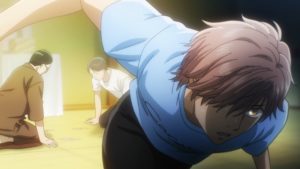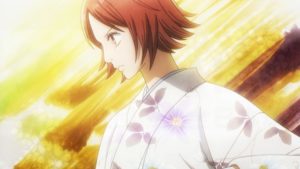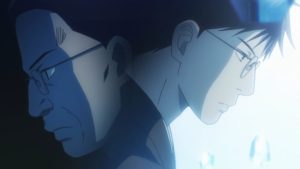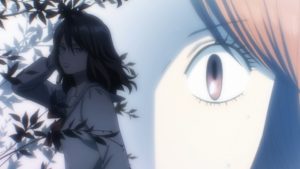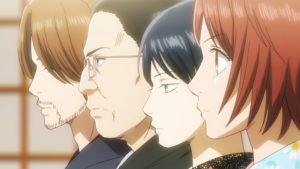Back in October of last year, I wondered whether Chihayafuru’s foundation of unceasing karuta matchups and unrequited love would have lost its luster by the third season’s end. Now that we’ve reached that point, I have to say that the series approached that limit several times over these last 24 episodes. When it first reappeared on screen after a six year hiatus, I was taken aback by its consistency, but small issues cropped up as the story ran its course (more on those in a bit). These problems were cause for reflection – was the 2019 incarnation of this show really that different, or had my expectations changed? After some thought, I arrived at an answer: the show was, in fact, different, but it still met my primary expectation. Despite some stumbles in its third season, Chihayafuru’s continued success aligns with my core belief about narrative fiction: character is king.
Chihayafuru’s cast is massive, spanning multiple high school clubs and karuta associations across several Japanese prefectures. While Chihaya, Taichi and Arata are clearly the story’s main figures, the series does an excellent job of splitting its time between different locations and checking in with secondary players. Fujisaki High School’s ultra-disciplined karuta club, in particular, had an increased role this season, making full use of Sakurazawa-sensei as a mentor for Chihaya as well as her own students. Sakurazawa also filled the roles of friend and old rival to new character Haruka Inokuma, giving them both an extra dimension in the process. As a former karuta Queen turned stay-at-home mom, Inokuma’s struggle to balance her two selves was fascinating to watch, and she quickly became my favorite anime character of last year. That Chihayafuru was able to build such an excellent introduction for her while juggling the lives of half a dozen other top players is a testament to its skill.
Inokuma was able to grab so much screen time due to this season’s primary storyline: crowning the karuta world’s new Meijin and Queen. Episodes 7-20 were dedicated to this arc, from the initial qualifying tournaments all the way to the title matches. This emphasis on individual play was season 3’s biggest departure from the show’s earlier incarnations, which balanced solo and team tournaments with aplomb. The decision to highlight individual competition wasn’t a problem in and of itself, as it gave us deeper looks at characters like Meijin Suo, Harada-sensei, and the aforementioned Inokuma. One of the consequences of this structure, however, was that its focus on top-level play came at the expense of some original cast members’ participation. Mizusawa’s karuta club, once the center of the show’s universe, was made largely irrelevant by this sudden shift. Nishida and Tsutomu in particular were done a severe disservice by this season’s scripts – I’d argue that their last worthwhile contribution to the story came in the third episode. (To put that in perspective of the larger series, that’s number 52 of 74.)
This wasn’t season 3’s only weakness, however. Its seventh episode saw Chihaya, perhaps the biggest karuta nut in the Japanese archipelago, turn down the opportunity to participate in the Queen qualifier tournament in favor of going on her class trip. This uncharacteristic decision was part of a larger story about her desire to become a high school teacher, which was haphazardly introduced, then largely forgotten until the season finale. During that forgetful period, the show delivered a large number of exciting karuta matches while Chihaya sat on the sidelines, which caused the show to split its attention between the players and the audience. That divided focus, in turn, resulted in many games skipping to their conclusions prematurely, without a sense of tension being carried throughout the full match. This was a sore spot for me until I realized that the series’ commitment to Chihaya and Taichi’s emotional lives mandated a certain amount of time spent in their heads (rather than on matches that didn’t involve them). Still, it would take both hands to count the number of karuta-related anticlimaxes contained in this season.
Even taking these complaints into account, S3’s structure was not fundamentally unappealing. The show found ways to involve Chihaya and Taichi in the stories of its elite players, whether it was as practice partners, pillars of support (Chihaya to Shinobu), or future apprentices (Taichi to Suo). The show periodically celebrated holidays and birthdays to create opportunities for charming character moments, and checked in with other schools during a graduation episode that eased the story into its final year. The love triangle between the golden trio was engrossing, but never swallowed the plot as I had feared it might. Notably, this was the best season yet for Arata, whose memorable romantic confession, impending rivalry with Suo, and budding interest in team play deepened his character considerably. He also made it quite far during the Meijin arc, which was a treat to watch (impossible comebacks and blown leads notwithstanding).
Would it be fair to label Chihayafuru’s third season a mixed bag? I don’t think so – the series remains one of the best competition-themed anime of the past decade. This newest batch of episodes had its ups and downs, but the highlights undoubtedly outweighed the low points. That’s true on a visual level, as well – Chihayafuru’s presentation experienced only a few small bumps during the last six months. Split-screen layouts and overlapping character profiles are no substitute for laborious animation, but here they did the job just fine. After all, this series is wholly dedicated to its characters; doubting teenagers, conflicted mothers, aging hotshots, and lonely champions are the reasons to watch this show. Some players received more attention than others, but I don’t begrudge them their journeys. Watching the evolution of Chihayafuru’s densely-populated universe remained a distinct pleasure during this third season. I’ll be waiting for the fourth, even if it takes another six years.

